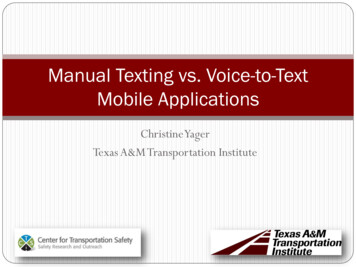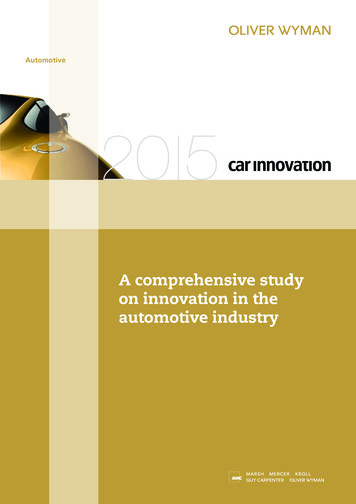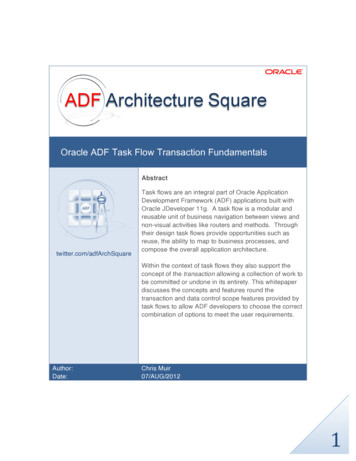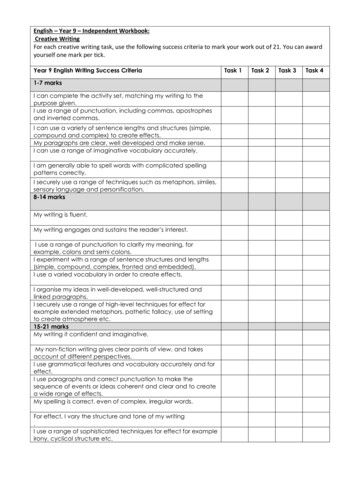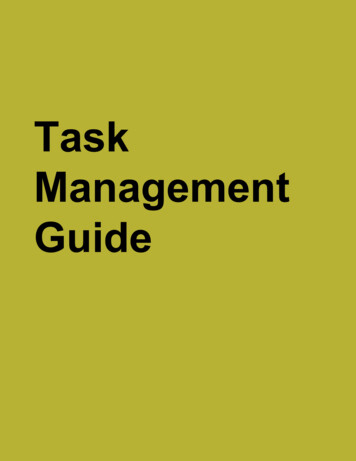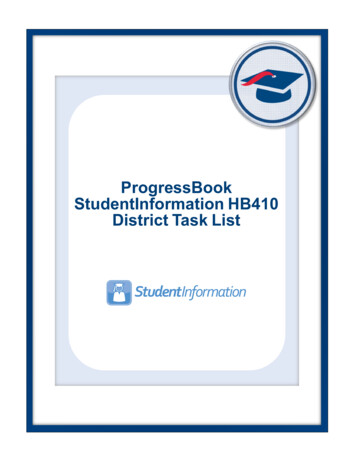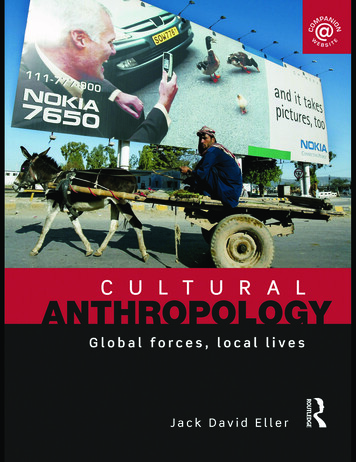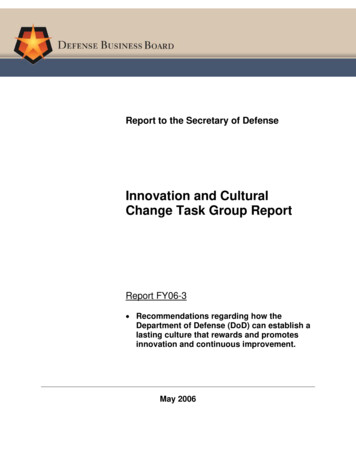
Transcription
Report to the Secretary of DefenseInnovation and CulturalChange Task Group ReportReport FY06-3 Recommendations regarding how theDepartment of Defense (DoD) can establish alasting culture that rewards and promotesinnovation and continuous improvement.May 2006
Defense Business BoardINNOVATION AND CULTURAL CHANGETASK GROUP REPORTTASKIn March 2006, Deputy Secretary of Defense, Gordon England, askedthe Chairman of the DBB to form a Task Group to assess and providerecommendations for the Department of Defense (DoD) to establish alasting culture that rewards and promotes innovation and continuousimprovement (Appendix A). As outlined in the 2006 Quadrennial DefenseReview (QDR), the Department has embarked on a “revolution inmanagement, technology and business practices.” Successful enterprisetransformation depends on the extent the Department’s people embrace(and learn) the new guiding principles espoused in the QDR: rewardinnovation; collaborate and share information; become agile, flexible,responsive to stakeholders, accountable, and efficient; and promote a moreintegrated and transparent decision-making culture and process.Specifically, the Task Group was asked to provide the followingactionable recommendations:1. Benchmark private sector best practices of companies most notedfor successful innovation and change management, such as 3M,Hewlett-Packard, UPS, Microsoft, eBay, IBM, etc., identify criticalcommon elements necessary to successfully create and sustainan enterprise culture that believes that innovation creates value forall stakeholders.2. Provide an assessment of the Department’s enterprise culture andrecommend actions to overcome current barriers to establishingand sustaining a lasting culture that rewards and promotesinnovation and continuous improvement.Task Group Chairman: Henry DreifusTask Group Members: Barbara Barrett, Herman Cain, Jim Haveman,James Kimsey, Mortimer ZuckermanTask Group Sponsor: Deputy Secretary of Defense, Gordon EnglandTask Group DoD Liaison: Michael Dominguez, Assistant Secretary ofthe Air Force, Manpower and Reserve AffairsTask Group Executive Secretary: Kelly Van Niman (DBB ExecutiveDirector)INNOVATION AND CULTURALCHANGE TASK GROUP1REPORT FY06-03
Defense Business BoardPROCESSThe Task Group interviewed current and retired DoD leaders,reviewed multiple previous studies and research and engaged outsideexperts. For example, during the March 8, 2006 DBB meeting, DBBMembers received a background briefing by Dr. Marietta Baba on“Organizational Change Management – A Systematic Approach to theTransformation of People, Organization and Culture” (Appendix B). Dr.Baba is a renowned industrial anthropologist who has advised leadingcorporations such as Motorola, Proctor & Gamble, Whirlpool, IBM and Fordon successful organizational and cultural transformations. Dr. Baba isDean of the College of Social Science, and Professor of Anthropology, atMichigan State University. The Board is grateful for her time, insights andguidance.Additionally, on March 8th, Dr. Christopher Lamb of the Institute forNational Strategic Studies briefed the Board on the critical issues related tothe strategic and organizational changes required to create a betterPentagon decision culture (Appendix C). The Board is grateful for Dr.Lambs’ insights and assistance.The Innovation and Cultural Change Task Group worked inconjunction with three other concurrent DBB Task Groups, and collectively,their work encompassed the critical focal points for realizing sustainableDefense enterprise transformation – people, culture and organization. TheTask Group Chairmen worked closely together to provide a unifiedapproach. The three other Task Groups were: Shaping and Utilizing theSenior Executive Service (SES) within the Department, Creating a ChiefManagement Officer in the Department of Defense, and Governance –Alignment and Configuration of Business Activities.Each of these Task Groups shared the common goal of improvingoverall organizational performance. Research has shown that realization oflasting improvements requires an integrated approach to changes inmanaging people, culture and organization. This Task Group report shouldbe considered in the context of the additional reports mentioned above andpublished on the DBB website at www.dod.mil/dbb. The Task Groupspresented their findings and recommendations to the full Board on May 31,2006 (Appendix D).INNOVATION AND CULTURALCHANGE TASK GROUP2REPORT FY06-03
Defense Business BoardRESULTSDuring the May 31, 2006 deliberations, the Board agreed (consistentwith the research presented by Dr. Baba) that (1) any effective approach toorganizational change management must begin with a strategic vision thatgenerates clearly articulated business goals and metrics that will be appliedto measure results; and (2) lasting change is determined in part by thenature of the imperative for change – the more urgent and compelling thisimperative, the more likely lasting change will result. The Boardemphasized the need to create “triggers” for change and other “forcingfunctions” with goals and timelines.The Department has multiple, interlaced cultures that perceive theenterprise differently. These organizational cultures comprise both similarand dissimilar values, beliefs, assumptions and behaviors by theirorganizations’ people. Best practice companies unify multiple cultureswithin their organizations through a shared vision and purpose that isclearly communicated and reinforced by leadership. Continuous trainingand clear communications are critical, best practice tools applied byindustry to support an organization’s strategy and vision, and to sustaintransformation and innovation within the organization.Since transformation of organizational processes is a result ofchanges accomplished by people, process change requires people’sbehavior (as well as values, beliefs and assumptions, e.g. culture) tochange. Therefore, the Board recommended that consistent with industrybest practices, the Department should accept and explicitly apply “culture”as one of the key levers to transform the enterprise.Senior DoD leadership is responsible and accountable for guidingand fostering a transformed culture, and must use various communicationtools to accomplish this mission. The Department should apply enterprisewide Knowledge Management tools, such as “Army On-Line” to achieve amultiplier effect of sharing knowledge at every level within the organization.Further, the Department should engage the SES corps to drive and sustainthe desired culture and outcomes – teamwork and collaboration.The Department must reward and encourage behavior that drives thedesired cultural change in order to create a purpose-driven, results-orientedand aligned organization. The Board offered several specificrecommendations which could be adopted by the Department, including theINNOVATION AND CULTURALCHANGE TASK GROUP3REPORT FY06-03
Defense Business Boardcreation of “circles of excellence” awards and events for Pentagon “changeagents” who promote innovation and continuous improvement.In summary, the Board made the following recommendations:1. Recognize and use “culture” as a change tool.2. Develop and promote guiding principles as part of a sharedvision.3. Communicate the desired culture to all levels of the enterprise.4. Encourage, reward and continuously reinforce change.CONCLUSIONThe current Defense enterprise promotes a risk-averse culture that isafraid to fail and strongly resists change. For the Department’s leadershipto achieve the goal of creating a lasting culture that rewards and promotesinnovation and continuous improvement, it must start by articulating acommon, strategic vision for the Department that will impel a purposedriven organization. Such a vision should be part of a comprehensive,enterprise Strategic Plan that defines the desired organizational culturerequired to achieve enterprise goals and provide effective support to thejoint warfighter.Respectively submitted,Henry DreifusTask Group ChairmanINNOVATION AND CULTURALCHANGE TASK GROUP4REPORT FY06-03
Defense Business BoardAttachments:Appendix A: Terms of Reference MemoAppendix B: Dr. Marietta Baba, “Organizational Change Management –A Systematic Approach to the Transformation of People,Organization and Culture”Appendix C: Dr. Christopher Lamb, DoD Organizational StrategyAppendix D: May 31, 2006 DBB Opening Presentation Slides andInnovation and Cultural Change Task Group FinalPresentationINNOVATION AND CULTURALCHANGE TASK GROUP5REPORT FY06-03
Defense Business BoardAPPENDIX A(Terms of Reference)INNOVATION AND CULTURALCHANGE TASK GROUP6REPORT FY06-03
Defense Business BoardINNOVATION AND CULTURALCHANGE TASK GROUP7REPORT FY06-03
Defense Business BoardINNOVATION AND CULTURALCHANGE TASK GROUP8REPORT FY06-03
Defense Business BoardAPPENDIX BDr. Marietta Baba“Organizational Change Management – A SystematicApproach to the Transformation of People, Organization andCulture”INNOVATION AND CULTURALCHANGE TASK GROUP9REPORT FY06-03
Defense Business BoardOrganizational Change Management – a Systematic Approach to theTransformation of People, Organization and CultureMarietta L. Baba(February 28, 2006)Vision and ObjectivesIn the recently released Quadrennial Defense Review (QDR), theDepartment outlined a vision to reshape the Defense Enterprise, to includeits structure, processes and culture. The QDR calls upon the seniorleadership of the Department to establish an organizational culture thatfosters innovation and excellence. The Department seeks to create aDefense support infrastructure that is agile, flexible and horizontallyintegrated. To achieve this vision of lasting cultural change that promotesinnovation and excellence, the Department of Defense must develop clearstrategies to transform not only its business processes, the associatedinformation systems supporting them, and the organizations in which theyreside, but also strategies to transform its people and culture.Organizational TransformationEnterprise transformation cannot be delivered with the human skills,business processes, organizational structures and cultures that werecreated decades ago. To support the DoD’s vision for a flexible, agile, andhorizontally integrated enterprise, there is an urgent need fortransformation in ways of doing business that are compatible with 21stcentury business processes and technological capabilities andrequirements.This latter statement reflects a fundamental principle underlying sociotechnical systems (STS) theory, a framework for understandingrelationships between technology, organizations and people, which holdsthat all work organizations, public and private, are socio-technical systemsthat combine interdependent technical (including technology, systems, andembedded processes) and human or social (including people, organization,and culture) elements. These elements rely upon one another to deliverresults; neither can accomplish its objectives without interactions betweenthem. The nature of their interaction determines how effective and efficientan organization can become.Because technical and social elements form an interacting system, majorINNOVATION AND CULTURALCHANGE TASK GROUP10REPORT FY06-03
Defense Business Boardchange in the technical elements require changes in human and socialelements; e.g., if new information technology or a new business process isintroduced, personnel need new skills and roles, the organization needs toreconsider its work processes and designs, and everyone needs to learn torun the business in new ways. For example, purchasing and installing anew software system (i.e., technical change) does not automaticallyguarantee changes in people, organization, and culture. These dimensionshave to be changed through careful planning and execution by the peopleinside the organization.Organizational Change ManagementAny effective approach to Organization Change Management (OCM) mustbegin with a strategic vision that generates clearly articulated businessgoals and metrics that will be used to measure results. Chances for lastingchange are determined in part by the nature of the imperative for change––the more urgent and compelling the imperative, the more likely the chanceof lasting change. These points cannot be overemphasized.OCM works in tandem with technical change management, usuallymeaning changes in business processes and information technology andsystems, to deliver greater value to stakeholders through pursuit ofstrategic goals. The remainder of this document assumes that a technicalchange process is running in parallel with OCM [1]. A significant problemin technical change management is a tendency to underemphasize (orignore) organizational change. As a result, the majority of seriousdifficulties reported in technical change programs relate to OCM.There is no widely accepted theory of Organizational Change Management(OCM), however there are several mid-range theories and/or guidingprinciples regarding organizational change that represent current leadingpractices. If used together, they can create a mutually reinforcing field thatmakes directional change more likely. Leading practices represent OCMas a process involving several phases, including: 1) an organizationalreadiness assessment; 2) planning and implementation of key elements ofOCM; and 3) assessment of OCM activities and continuous improvement.Phase I: Organizational assessment. Before implementing majorchange in any organization, it is crucial to assess the organization’s1 The full version of this document contains additional sections focusing on Enterprise Resource Planning (ERP) asan example of technical change, and provides a more detailed discussion of OCM for ERP.INNOVATION AND CULTURAL11REPORT FY06-03CHANGE TASK GROUP
Defense Business Boardbaseline state, which begins with an analysis of the organization’s ‘as-is’condition. A baseline assessment gives an indication of those factors inthe organization that will support the ‘to be’ vision for change (resources, orforces for change), and those that may pose impediments to change (risks,or forces against change). In OCM, the resources are used to facilitate thechange process, while risks are reduced, eliminated or managed toneutralize their effects. Baseline assessment begins with an understandingof the vision or ‘to be’ state, and then compares these requirements withthe ‘as is’ state (i.e., a gap analysis). Making the gap explicit clearlyhighlights the reasons why change is necessary, and can provide ablueprint for actions needed in Phase II. Specific factors assessed in thisphase are contingent upon the nature of the organization’s strategy,performance goals, and targeted technical change (i.e., the ‘to be’ state).Phase II: Planning and Implementing Key Elements of OCM.Organizational transformation is facilitated by six elements of OCM that aredescribed below. When implemented in concert, these elements improvethe chances that a transformation initiative will meet its goals. Theseelements are used to actively manage change–to facilitate change ‘on theground.’ Thus, if our organization faces specific risks in the implementationof new technology or any other aspect of logistics modernization, these sixOCM elements can be very useful in helping us to reduce, eliminate, and/ormanage the specific risks. These elements also can draw uponorganizational resources to strengthen change processes.OCM Element #1: Leadership. Leaders create and articulate a vision forthe future that is compelling and motivating, and they move ahead of othersand show the way. This is necessary when people face an uncertainfuture, and fear risk of loss. Such leadership cannot be delegated to thetechnical team; it has to be owned by the top. The strongest leadership isprovided when the leadership team throughout the organization is alignedaround a consistent message for change, up and down the chain ofcommand and across all organizational units. Such alignment requiressignificant management education and communication. Leadership shouldbe distinguished from sponsorship and from champions, who also are veryimportant to transformation efforts. They are typically higher-levelmanagers who take responsibility for oversight and support of atransformation initiative by removing barriers and providing resources.OCM Element #2: Communication. Different types of individuals may‘buy into’ new ideas or technologies at different points in times (e.g.,innovators versus early adopters), and there is a ‘buy-in’ process thatINNOVATION AND CULTURALCHANGE TASK GROUP12REPORT FY06-03
Defense Business Boarddepends upon effective communication at each stage in the process.Different sources of information, and different kinds of communicationchannels, are important at different stages (e.g., mass communication,opinion leaders). If a formal communications program is not established,then an informal one will grow up spontaneously, as people struggle tomake sense of what is happening around them. ‘Out of control’communications usually mean that rumors rule, and this can be a seriousforce against change, especially if the transformation effort runs intodifficulty.OCM Element #3: Organizational Evolution. To achieve significantperformance improvements, a business must consider improvements inwork process and organizational structure. These may be enhanced,streamlined, eliminated, or new ones may be invented. Lean processesand reengineering can streamline work and information flow acrossorganizational units, eliminating non-value added activity. Some processesmay be outsourced. Other possibilities are acceleration, task improvement,and output improvement. Generally, it is advised that such activities beconducted in conjunction with the implementation of new informationtechnologies to enable the greatest gains in efficiency. Innovativeorganizational designs and incentives also can encourage practices thatsupport enterprise integration.OCM Element #4: Participation. The greater the degree of participationan individual has with an activity, the more likely it is that he or she willexperience a sense of ownership and buy-in, meaning acceptance of theactivity as legitimate and worthwhile for the organization. People are morelikely to give their best ideas to an effort in which they feel some ownership.To facilitate participation, the OCM process should respond positively tomembers’ questions and challenges by engaging such individuals – reachout and involve them on a systematic basis, and find ways to involve theirpersonal networks. Also, encourage and support involvement byrecognizing and rewarding individuals who provide outstanding service toenterprise integration efforts.OCM Element #5: Education and Training. A horizontally integratedenterprise requires more than transactional training––it takes a learningorganization approach, in which the entire organization supports learning.Users of new technology should understand not only their own job-relatedfunctions, but also the work process flow upstream and downstream fromtheir positions, so that they can conceptualize the logic underlying thesystem, and be prepared to troubleshoot and help others. We need toINNOVATION AND CULTURALCHANGE TASK GROUP13REPORT FY06-03
Defense Business Boardadopt best practices that ensure learning is taking place in each class, notonly attendance. Lead users are another critical concept to anchorcomplex new technologies in a learning organization. There also should bea well thought out provision for management education. A truly integratedenterprise requires that managers understand the transformation, and howto run an integrated enterprise.OCM Element #6: Resistance Management. When individuals inpositions of authority work against transformation, either openly or behindthe scenes, then we face a serious force against change. Such individualscan mobilize or encourage others to resist and can create roadblocks thatare difficult to overcome. It is not accurate to characterize all resistance asnegative; it can play a constructive role as well. Sometimes those whoresist have good reasons, and they always should be given a fair hearing.If resistance is based on the accurate perception of disadvantage, it maybe possible to work out means to lessen the difficulty. Whatever the case,do not ignore resistors in positions of authority. This is liable to makematters worse in the long run.Planning and Implementing Change. The process by which the gapsidentified in Phase I are closed to achieve the vision using the six OCMelements described above is a complex and challenging process thatrequires both planning and execution by a strong leadership team.Leadership must own the plan and its implementation, or chances forlasting change decline. Each of the elements described above should beplanned and executed under the guidance of an OCM leader who reportsdirectly to the top team, together with technical leadership.Phase III. Assessment of OCM Activities and ContinuousImprovement. To reflect the importance of effective organizational changemanagement to the long-term success of Enterprise Transformation, it isvital that these efforts be assessed and revised based on feedback frompeople engaged in work at the implementation sites. An assessmentprocess should be established in collaboration with the organization, andon-site assessments conducted periodically. Results should be reported toleadership at the same time technical progress is reported.INNOVATION AND CULTURALCHANGE TASK GROUP14REPORT FY06-03
Defense Business BoardAPPENDIX CDr. Christopher LambDoD Organizational StrategyINNOVATION AND CULTURALCHANGE TASK GROUP15REPORT FY06-03
Why and Where Change is Needed(not just a leader issue)New Strategic Environment:New strategy-driven imperatives: Volatile environment Contend with uncertainty (i.e. complexity) Diffusion of knowledge lowers barriers tocompetition Make decisions quickly with betterintegration from global perspective Global security challenges and capabilities Fuse DoD efforts with allies & other agencies Asymmetric and disruptive challenges Nimble and adaptive enemiesCOLLABORATION Missions demand it Exploit military transformation; others willAGILE, ADEPT & ADAPTIVEGoals, Policy and StrategyForce Generation Vision, strategy, planning parameters Acquisition, Logistics, Science and Tech– Strategic Communications Manpower Needs and resource allocation Education and Training– Capabilities-Based Force Development Bilateral/Multilateral relationsInstitutional Management– Security Cooperation Net Assessments Outreach (Legislative and Public Affairs) Administration and Management (Legal,Operational GuidanceInspector General, etc.) Contingency planning– Adaptive Planning Financial Accountability Current force allocation– Global Force Management Force Employment Oversight Concepts and DoctrineCommonAnalytic TasksCOLLABORATIONPracticehas notfollowedtheory.How doweactuallydo it?
QDR Senior Leadership Focus A key measure of success is the extent to which the Department’s seniorleadership is able to fulfill the following functions:– Strategic Direction Identify the key outputs – not inputs – they expect from the Department’s componentsand determine the appropriate near-, mid-, and long-term strategies for achieving them.Such outputs will be focused on the needs of the President as Commander in Chief andthe joint warfighters.– Identity Establish an organizational culture that fosters innovation and excellence.Communicate the Department’s strategy, policy and institutional ethos to the internalworkforce and to external audiences.– Capital Acquisition and Macro Resource Allocation Shape the Department’s major investments in people, equipment, concepts andorganizations to support the Nation’s objectives most effectively.– Corporate Decision Making Implement agile and well-aligned governance, management and work processes.Ensure the Department has the processes, tools and transparent analyses to supportdecisions.– Performance Assessment Monitor performance to ensure strategic alignment and make adjustments to strategicdirection based on performance.
Organizational StrategyProblem Can’t make strategic tradeoffs well or quickly enough Can’t allocate resources effectively in support of strategy––––––SECDEF is first point for end-to-end problem and solution identificationHe does not have the necessary time or decision supportRoles and functions are confusedCommittees are ineffectual; not configured or empowered for actionCollaboration is not rewardedAll this is true for the Interagency as wellCost Enemies make decisions, act, and adapt faster than we do Enemies exploit the “seams” and gaps in our security postureSolution Organizational strategy for producing desired outcomes and for who does what Then export the strategy to the interagencyQDR Senior leader focus on five key responsibilities Under “Additional Governance Reforms” DoD is said to be considering:–Designating a single lead advocate for the future joint warfighter
Horizontal OrganizationsProblem Rigidly-vertical organizations cannot produce integrated products quickly– Can’t collaborate with one another or with other agencies– Can’t generate integrated options for senior leaders Senior leaders don’t feel supported; believe staff is too large– Middle management works hard but not to good effect Lack clear roles, responsibilities and understanding of desired outputs Can’t rationally allocate resources to capabilities to missions– Strategy not based on explicit choices between alternatives Can’t agree on how capabilities are measured or who should do soCost Senior leaders poorly supported despite large staff Capabilities not matched to strategic prioritiesSolution Empowered horizontal organizations for key strategic outcomes and assetsQDR Under “Additional Governance Reforms” DoD is said to be considering:– Creating new horizontal organizations
Decision SupportProblem Real options not vetted (volunteers dilemma) Information is not freely shared; it is used to persuade, not assess Leaders are not well informed on the risks of alternative courses of actionCost Inefficiency and less well informed decision makingSolution Decision support cell to assist SECDEF (and SLRG) with 5 core tasks Tees up major trades; conducts supporting strategic analysis; no recommendations Shifts culture to information sharing & comparative analysis Sets standards for decision support processes and products Administers analytic backbone through supporting horizontal organizations: Scenarios (MSFD conferences)Joint Operating ConceptsJoint Data (joint Data Support)Joint Methods of Analysis (Defence Modelling and Simulation Org)Operational Risk MetricsInstitutional Knowledge (Defense Technical Information Center)QDR Emphasizes information sharing and collaboration The Department will implement a more transparent, open and agile decisionmaking process common authoritative information sources common analyticmethods
Chief Administrative Officer andShared ServicesProblem Core functions are not well supported Supporting organizations do not recognize themselves as such They do not collaborate Demand is inflated by customers; supply is indifferent to the customerCost Inefficiency that draws resources from core functions “Friction” that degrades performance of core functions; sometimes in acrippling fashionSolution Chief administrative officer Shared services (market principles, not primarily consolidation)QDR Under “Additional Governance Reforms” DoD is said to be considering:–Migrating toward a shared services model for support functions
Defense Business BoardAPPENDIX D(Task Group Final Report – May 31, 2006)INNOVATION AND CULTURALCHANGE TASK GROUPREPORT FY06-03
Defense EnterpriseTransformation:Organization, Culture andPeopleA Systematic Approachfor“Team Defense”
Task ext StepsSecretary Rumsfeld Remarks:*“Just as we must transform America's military capability tomeet changing threats, we must transform the way theDepartment works and what it works on”.“Our challenge is to transform not just the way we deter anddefend, but the way we conduct our daily business”.“Every dollar squandered on waste is one denied to thewarfighter. That's why we're here today challenging us all towage an all-out campaign to shift Pentagon's resources frombureaucracy to the battlefield, from tail to the tooth.”*Extracts from Remarks as Delivered by Secretary of Defense Donald H. Rumsfeld, The Pentagon , Monday, September 10, 2001May 2006"Team Defense"2
Levers for Enterprise ltureMay 2006"Team Defense"3
Organization, Culture and People Organization– Formal structure of roles, relationships, processes, tasks,interdependencies, incentives and technology Culture– Informal learned patterns of behavior, thought, and feeling that areshared with newcomers People– Individual characteristics, knowledge, skills, abilities, attitudes andperceptionsMay 2006"Team Defense"4
Key Barriers to Change at DoD The Services are programmed to resist integration due to historical andlegal barriers Political oversight contributes to a risk and change adverse culture The split between military and civilian communities makes managementat the top difficult to coalesce Disparate AD HOC processes (formal / informal) are used as workarounds to current structure (organization / process / budgets) Current culture sees little reward in the benefit that a better DoDEnterprise management would provideMay 2006"Team Defense"5
Leadership owns organizational change“Many organizational change efforts havenot altered the behavior, focus andperformance of leadership which sets thetone for whether change is sustained ormere
desired cultural change in order to create a purpose-driven, results-oriented and aligned organization. The Board offered several specific . makes directional change more likely. Leading practices represent O


